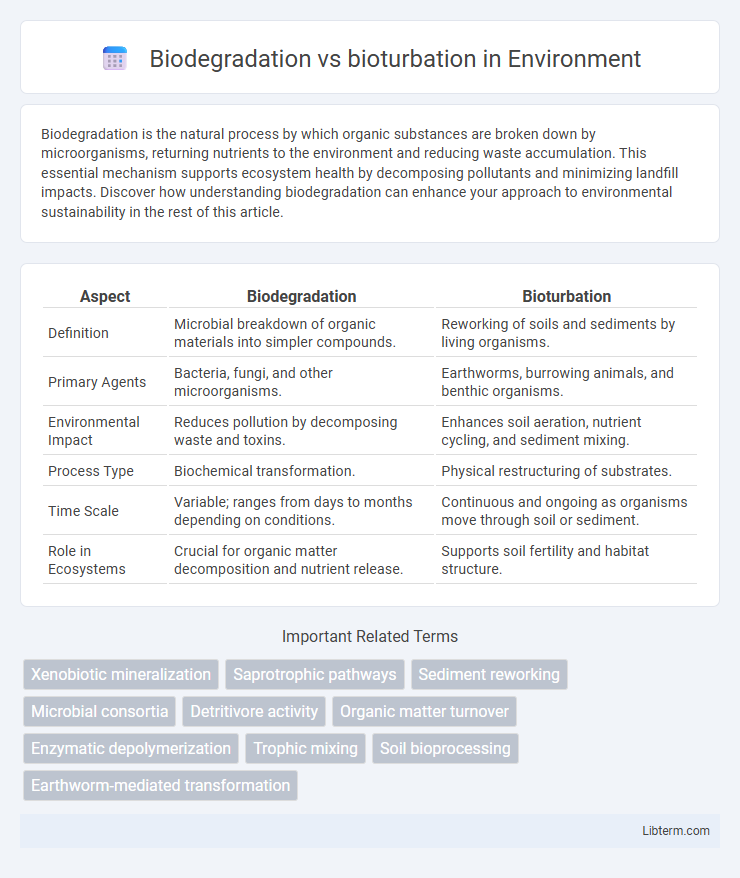Biodegradation is the natural process by which organic substances are broken down by microorganisms, returning nutrients to the environment and reducing waste accumulation. This essential mechanism supports ecosystem health by decomposing pollutants and minimizing landfill impacts. Discover how understanding biodegradation can enhance your approach to environmental sustainability in the rest of this article.
Table of Comparison
| Aspect | Biodegradation | Bioturbation |
|---|---|---|
| Definition | Microbial breakdown of organic materials into simpler compounds. | Reworking of soils and sediments by living organisms. |
| Primary Agents | Bacteria, fungi, and other microorganisms. | Earthworms, burrowing animals, and benthic organisms. |
| Environmental Impact | Reduces pollution by decomposing waste and toxins. | Enhances soil aeration, nutrient cycling, and sediment mixing. |
| Process Type | Biochemical transformation. | Physical restructuring of substrates. |
| Time Scale | Variable; ranges from days to months depending on conditions. | Continuous and ongoing as organisms move through soil or sediment. |
| Role in Ecosystems | Crucial for organic matter decomposition and nutrient release. | Supports soil fertility and habitat structure. |
Introduction to Biodegradation and Bioturbation
Biodegradation is the natural process by which microorganisms such as bacteria, fungi, and algae break down organic materials into simpler substances, playing a crucial role in nutrient cycling and environmental cleanup. Bioturbation involves the disturbance and reworking of soils and sediments by living organisms like earthworms, burrowing animals, and certain aquatic species, which enhances soil aeration and influences sediment texture. Both processes significantly impact ecosystem functioning by modifying organic matter and physical environments, yet they operate through distinct biological mechanisms and environmental effects.
Defining Biodegradation: Processes and Mechanisms
Biodegradation involves the enzymatic breakdown of organic materials by microorganisms such as bacteria and fungi, converting complex compounds into simpler substances like water, carbon dioxide, and biomass. This process relies on microbial metabolism and environmental conditions like oxygen availability, temperature, and pH to influence degradation rates and efficiency. Biodegradation plays a critical role in waste management, pollutant removal, and nutrient cycling within ecosystems.
Understanding Bioturbation: Key Agents and Effects
Bioturbation involves the reworking of soils and sediments by living organisms, primarily benthic invertebrates such as worms, mollusks, and crustaceans, which actively mix and aerate sediment layers. This biological activity enhances nutrient cycling, influences sediment structure, and impacts organic matter decomposition differently than biodegradation, which strictly refers to the microbial breakdown of organic compounds. Understanding bioturbation mechanisms provides critical insights into ecosystem engineering, sediment biochemistry, and habitat modification in aquatic and terrestrial environments.
Microbial Roles in Biodegradation
Microbial communities play a critical role in biodegradation by enzymatically breaking down organic pollutants into simpler, non-toxic compounds through metabolic processes. These microbes, including bacteria and fungi, utilize enzymes such as oxygenases and hydrolases to degrade complex molecules like hydrocarbons, plastics, and pesticides in various environmental matrices. Unlike bioturbation, which physically disturbs sediments through the activity of macrofauna, microbial biodegradation fundamentally transforms chemical structures, enhancing pollutant removal and ecosystem restoration.
Organism Contributions in Bioturbation
Organism contributions in bioturbation are critical for sediment mixing and nutrient cycling, as burrowing animals such as worms, crustaceans, and mollusks disrupt sediment layers and enhance oxygen penetration. These activities accelerate organic matter degradation by increasing microbial activity and altering sediment chemistry. Unlike biodegradation, which involves enzymatic breakdown by microbes, bioturbation physically rearranges sediments, creating microhabitats that promote diverse microbial processes essential for ecosystem functioning.
Environmental Factors Influencing Biodegradation
Environmental factors such as temperature, pH, oxygen availability, and moisture content critically influence biodegradation rates by affecting microbial activity and enzyme function. Nutrient availability, including nitrogen and phosphorus levels, determines microbial growth necessary for the decomposition of organic matter. Soil texture and pollutant concentration also modulate biotic degradation efficiency, with optimal conditions enhancing microbial metabolism and pollutant breakdown.
How Bioturbation Alters Sediment and Soil Structure
Bioturbation significantly alters sediment and soil structure by mixing organic and inorganic materials through the movement of organisms such as worms, insects, and burrowing animals. This biological agitation enhances nutrient cycling, aeration, and water infiltration, promoting a dynamic and heterogenous environment critical for soil health and sediment stability. Unlike biodegradation, which primarily involves the chemical breakdown of organic matter by microbes, bioturbation physically restructures the sediment layers, influencing ecosystem processes and habitat conditions.
Interactions Between Biodegradation and Bioturbation
Interactions between biodegradation and bioturbation significantly enhance organic matter decomposition in sedimentary environments. Bioturbation, driven by benthic organisms, increases sediment mixing and oxygen penetration, accelerating microbial activity responsible for biodegradation. This synergistic relationship fosters nutrient cycling and influences carbon sequestration rates in aquatic ecosystems.
Applications in Environmental Remediation
Biodegradation plays a crucial role in environmental remediation by breaking down organic pollutants into less harmful substances through microbial activity, enhancing soil and water quality. Bioturbation complements this process by promoting sediment mixing and aeration via the movement of organisms such as worms and burrowing crustaceans, which accelerates pollutant degradation and nutrient cycling. Combined applications of biodegradation and bioturbation improve the efficiency of bioremediation strategies, particularly in contaminated wetlands, marine sediments, and industrial waste sites.
Future Directions in Biodegradation and Bioturbation Research
Future directions in biodegradation research emphasize enhancing microbial consortia for improved breakdown of complex pollutants and exploring genetic engineering to boost enzymatic efficiencies. Bioturbation studies are increasingly integrating advanced imaging and modeling techniques to quantify sediment mixing impacts on nutrient cycling and contaminant fate. Combining these approaches fosters a holistic understanding of biodegradation processes intertwined with bioturbation-driven ecosystem functions, promoting sustainable environmental remediation strategies.
Biodegradation Infographic

 libterm.com
libterm.com